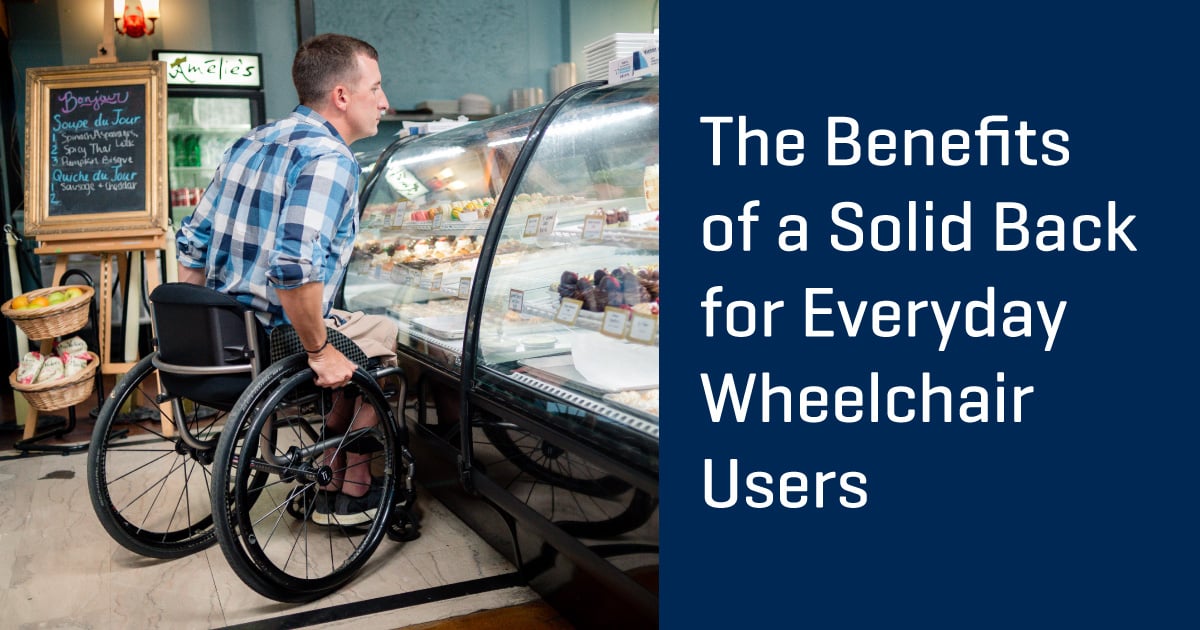Benefits of the right back support:
For a person who uses a wheelchair most of the time, the back support plays a key role in optimizing function and independence. A solid back support for an individual, especially one who utilizes a rigid manual wheelchair, may accomplish some or all the benefits below:
- Provide trunk stability and balance by supporting the natural curves of the spine
- Enhance the cushion in promoting pelvic stability and pressure redistribution to minimize peak pressures
- Decrease the likelihood of/or progression of postural abnormalities
- Decrease pain and increase sitting tolerance
- Promote optimal function, safety, and independence by increasing the connection and responsiveness of the manual wheelchair
Sling back vs solid back?
When considering a standard sling back or a solid back, a thorough physical and functional therapy evaluation needs to be done that will include assessments of range of motion, strength, tone, and balance. The therapist can then determine whether a solid back support would be better than a sling back by asking the following questions:
- Is the client at risk of or already have a postural abnormality that affects pelvic and/or trunk stability and alignment?
- Is the natural ‘give and take’ of upholstery affecting the client’s posture, function or independence?
- Does the client complain of pain while using their wheelchair?
If the answer is yes to any of these, a solid back support should be considered. The therapist should then have the client sit on a mat table and determine the amount of support needed and at what level of the trunk it is needed to optimize stability and function. They can do this using their hands to simulate the amount and level of support.
How do I know which solid back to choose?
Back supports include various shape options. When looking specifically at back supports for people who propel independently and function well in an appropriate wheelchair, the shape differences relate more to the contouring. These backs typically are shorter to allow freedom of movement of the upper extremities. Depending on the level of injury, each person will be unique in how much lateral contouring they require and prefer to function well in daily tasks. When the therapist has determined the appropriate length of a back support, the amount of contouring can be determined. This can be done in the same way as determining length: on the mat, using their hands to simulate the amount of lateral support needed to maintain an optimal posture. This amount of support can then be provided by a back support that has the amount of lateral contouring required. If more customized support is required, lateral trunk supports can be considered.
2. Medium
The medium of the back support shell and hardware is very important, especially for an active user. They can be made from various materials, which can impact the weight of the back and, ultimately, the entire wheelchair system. The goal is to keep a system as lightweight as possible to make propulsion, and loading/unloading the chair in the vehicle as easy as possible. When assessing a back support, take the cover off and look at the shell. The most common material is aluminum as it is durable while remaining relatively light weight. Carbon fiber is also becoming a more affordable option and is often preferred due to the increased strength to weight ratio, allowing the backrest to be very lightweight. Hardware materials vary greatly, so be sure to include the weight of the hardware when assessing the weight of the back support.
The backrest insert medium can be foam, air, or a combination of foam and air. The medium can have a significant impact on function and should not be taken lightly. For example, if a person using a wheelchair relies on the back support stability when performing lower body dressing, the firmness of the foam can impact that stability. A back support with only air cells could possibly make the back seem less stable for someone who needs a firm surface for stability. Of course, every individual is unique, so a functional trial is always recommended to ensure the individual can complete daily tasks safely and efficiently.
3. Adjustability
This feature is one of the most important when looking at a back support. Angle and depth adjustability are achieved through the hardware. So, when assessing a back support, a good look at the hardware and how it works is important. The key adjustment for any back support is angle adjustability. Simply opening the seat-to-back angle can significantly improve stability, comfort, and function
As you can see, there are many factors to consider in selecting an appropriate back support for an active wheelchair user. Permobil now has a complete line of back supports to meet the needs of individuals with an active lifestyle. The Agility Active series is designed to stabilize the person’s pelvis and trunk, utilizing lightweight shell materials. The minimal backrest hardware offers 15 degrees of discrete angle adjustment forward and rearward while not weighing the seating system down. Check out the entire Agility Active series here!
 Stacey Mullis, OTR/ATP
Stacey Mullis, OTR/ATP
Director of Clinical Marketing
Stacey serves as Director of Clinical Marketing for Permobil. A practicing OTR for over 20 years, she has experience in school-based pediatrics, inpatient rehabilitation, long term care, and home health. With her interest in wheelchair seating and positioning, Stacey engaged the challenges of providing appropriate seating in various clinical settings. She now uses this experience to develop programs and resources to educate clinicians on the principles of seating and wheeled mobility. She is passionate about equipping clinicians and through her previous role as Director of Clinical Education with Comfort Company and now with Permobil she has taught nationally and internationally to increase therapist capacity in this specialty area. Mullis graduated from Western University in London, Ontario, Canada with a BA Linguistics and BSc Occupational Therapy. She is a member of the NCOTA, CTF Executive Board, NRRTs, RESNA, and AOTA.

Tricia Garven, MPT, ATP
Regional Clinical Education Manager
Tricia is currently a Regional Clinical Education Manager at Permobil. Prior to joining the clinical team at Permobil, she was in a similar role as the Clinical Applications Manager for ROHO. Previously, in clinical practice, Tricia specialized in neuro rehabilitation at Baylor Institute for Rehabilitation (BIR) in Dallas, Texas. While working at BIR, she gained extensive knowledge in the prescription and training of custom wheelchairs and seating. She also worked as the outpatient wheelchair seating clinic specialist. Now with Permobil, Tricia is presenting educational programs to therapists and DME providers regarding seating, mobility and pressure ulcer prevention. Tricia is an active member of RESNA, Clinician’s Task Force, and the APTA. Within the APTA, Tricia is a member of the Neurology Section as well on the nominating committee for the newly formed AT-SWM SIG.

